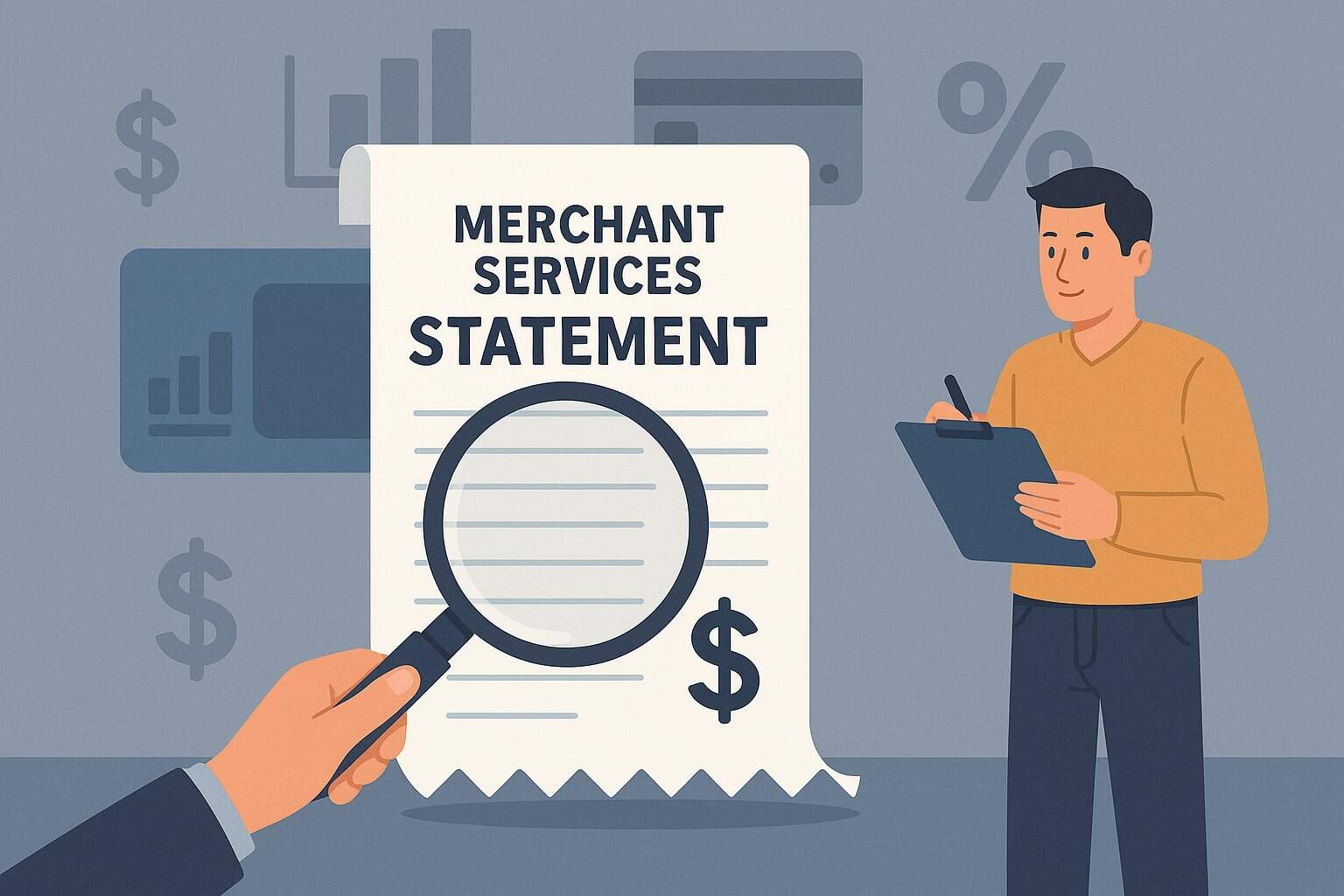
By alphacardprocess October 10, 2025
Auditing your merchant services statement is a critical activity for any business that processes credit cards, debit cards, or digital payments. A thorough audit helps you uncover hidden fees, incorrect charges, and opportunities to negotiate better rates or switch providers.
This guide dives deep into each area you should examine, step-by-step, so you can maximize savings and understand every line of your statement.
Understanding Your Merchant Services Statement

A merchant services statement is a monthly or periodic billing document from your payment processor or acquiring bank. It lists all the fees, rates, and adjustments associated with processing electronic payments.
While every provider has its own format and naming conventions, most statements will include categories like interchange fees, assessment fees, assessment passes, markups, adjustments, and chargeback fees.
When you audit your statement, you aim to understand: (1) what fees you are being charged, (2) whether those fees are correct and competitive, and (3) whether there are opportunities to eliminate or reduce unnecessary charges.
An audit is not a one-time task—it should be performed regularly (e.g., quarterly) to track changes and catch surprises early.
Key terms to know before you start:
- Interchange fees: Fees charged by card networks (Visa, MasterCard, Discover, American Express) per transaction.
- Assessment fees: Network or card brand assessments, often passed through to the merchant.
- Processor markups: The margin or spread your payment processor adds on top of interchange and assessments.
- Batch and transaction fees: Fixed fees per batch (end-of-day deposit) or per transaction.
- PCI compliance fees: Fees related to maintaining Payment Card Industry data security standards.
- Chargeback and retrieval fees: Costs for handling disputes or information requests.
- Miscellaneous, monthly minimum, early termination, and statement fees: Additional line items some providers insert.
By dissecting these components, you gain clarity into where your money is going—and where it could be saved.
Step 1: Gather and Organize Historical Statements

Before you jump into line items, collect a set of statements over a meaningful period—ideally 12 months. This gives you context for seasonal fluctuations, trends, and anomalies. Organizing by month or quarter allows side-by-side comparisons.
Why you need multiple periods:
- Fee structures or processor terms can change mid-year without explicit notice.
- One bad month might hide issues you miss if you only look at a single statement.
- Patterns (e.g. sudden jump in fees in certain months) often point to misclassifications or errors.
Create a spreadsheet or ledger where each statement and its totals are recorded. Key columns to include:
- Month / Statement period
- Total volume processed
- Total number of transactions
- Gross charges (total sales)
- Total fees paid
- Effective rate (fees ÷ volume)
- Breakdown by major categories (interchange, assessments, markups, etc.)
- Any anomalies or extraordinary adjustments
Once the statements are organized, compute the effective rate for each period. Effective rate = (Total fees ÷ Total processed volume) × 100%. This gives you a baseline to compare across months and measure improvement.
Step 2: Identify and Isolate Interchange and Assessment Fees

Interchange fees and assessment fees together form the bulk of what you pay for accepting card payments. These are generally non-negotiable base costs, though in some cases their modifiers can be optimized. You want to isolate these to see what you’re paying to networks and how much your processor is marking up.
Interchange Fees
- These are set by card brands (Visa, MasterCard, etc.) and vary by card type (consumer credit, rewards, business, premium, debit, etc.).
- Interchange is often expressed in “tiered” or “interchange-plus” pricing plans (“plus” meaning additional markup over interchange).
- The statement should list interchange fees or pass-through amounts for each card category. Confirm that your processor correctly applied the proper interchange tier based on transaction type and size.
When auditing interchange:
- Match interchange line items to transaction volume in corresponding card categories.
- Check for misclassification—e.g. consumer vs commercial card, rewards vs non-rewards, or card-not-present vs card-present.
- Watch out for “downgrades” where your transaction is priced at a higher interchange category due to missing data (e.g. missing zip code, no AVS, missing CVC).
- Ensure that multi-currency or cross-border transactions are correctly flagged, as they often carry higher interchange.
Assessment Fees
- Card brand networks impose assessment fees (e.g. Visa, MasterCard network assessments) and these are often passed through.
- These can include brand assessments, acquirer assessments, network access & brand usage (NABU) fees.
- They are generally non-negotiable, but you should verify whether the exact rate is being passed through without additional markup.
When auditing assessments:
- Compare the assessment rate on your statement with the publicly published assessment rates for the networks.
- Confirm that no extra surcharge is being added over the published rate.
- Look for assessment passthroughs on any special card networks (e.g. fleet, corporate, premium).
By separating interchange + assessments, you can see exactly how much of your total cost is base cost vs how much is your processor’s margin.
Step 3: Scrutinize Processor Markups and Pricing Plan
Once you know your base costs (interchange + assessment), the next task is to audit what your processor is charging on top. These are the “markups” or “margins” and the pricing plan structure they use.
Pricing Structures
Common pricing models include:
- Tiered pricing: Transactions are bucketed into tiers (qualified, mid-qualified, non-qualified) with preset markup rates. This is less transparent and often costlier.
- Interchange-plus pricing (cost-plus): The processor charges the actual interchange + assessments plus a fixed markup (i.e. cents + percentage). This tends to be more transparent and may yield savings.
- Flat-rate pricing: A fixed percentage for all transactions (commonly used by some online or POS aggregator services). It’s simple but often more expensive for high-volume merchants.
- Subscription or membership pricing: A fixed monthly fee + low transaction costs.
- Blended pricing: A mix, sometimes with thresholds or caps.
Markup Audit
When auditing markup:
- Identify in your statement where processor margin or markup appears (often labeled “markup,” “acquirer markup,” “merchant discount,” or “service charge”).
- Compare markup rates per card category vs what was negotiated in your contract.
- For interchange-plus plans, confirm that the markup is flat and consistent (e.g. “0.20% + $0.10”) rather than variable.
- In tiered plans, examine how many transactions fell into each tier—sometimes a majority end in “non-qualified” which has higher markup.
- Be alert to hidden markups—some processors embed markup into “pass-through fees” or “network fees,” making them hard to spot.
Hidden Add-Ons
Beyond simple markup, processors sometimes sneak in additional charges such as:
- Residual fees: Small amounts kept on transactions after chargebacks or refunds.
- Platform fees: If you’re using an integrated POS or third-party software, check whether the processor is passing along extra integration fees.
- Currency conversion or cross-border markups: These sometimes carry additional spreads.
- Minimum monthly guarantee: Some contracts require you to pay a minimum even if your fees don’t reach that level.
- Equipment lease or rental fees: These may be bundled in your statement rather than requiring a separate equipment invoice.
By isolating and challenging each markup or add-on, you can often negotiate them down or eliminate them.
Step 4: Check for Flat Fees, Per-Transaction, and Batch Fees
In addition to percentage-based fees or markups, many merchant statements have fixed fees for individual transactions, batching, statement processing, or account maintenance. These can add up, particularly for high-volume merchants with smaller ticket sizes.
Per-Transaction Fees
- These are fixed cent-amounts (e.g. $0.10 or Rs. 2) levied per transaction, regardless of card type.
- They often appear as “transaction fee,” “authorization fee,” or “acquirer fee.”
- Multiply the per-transaction fee by the total number of transactions to see total cost.
Audit this by:
- Confirm that the per-transaction fee in your contract matches what appears on your statement.
- Ensure it is applied to every transaction and consistently.
- Look for surcharges or additional per-transaction “processing fees” not agreed upon.
Batch Fees / Settlement Fees
- Processors often charge a “batch” or “settlement” fee for each day you close (batch) your credit card transactions.
- If your business closes multiple times or batches more than once per day, these can be duplicative.
- The charge might be labeled “daily batch fee,” “settlement fee,” “deposit fee,” or “batch close fee.”
Audit batch fees by:
- Counting how many batch fees were applied relative to your batching frequency.
- Confirm that the batch fee matches your contract (e.g. Rs. 5 per batch or $0.10).
- Negotiate to bundle or reduce batch fees, especially if you batched many times per day.
Monthly / Statement / Account Maintenance Fees
- Many providers include fixed monthly fees for statement generation, gateway access, PCI scanning, account management, etc.
- These might include terms like “monthly service fee,” “gateway fee,” “statement fee,” or “account maintenance fee.”
Audit monthly fees by:
- Listing every fixed fee on the statement and their amounts.
- Verifying that each is in your contract.
- Eliminating redundant or duplicative fees—e.g. if your gateway provider also charges, check whether your acquirer is passing that along.
- If you’re paying for multiple services (e.g. POS software, gateway, PCI scanning), evaluate whether bundling or consolidating providers yields lower fees.
If your fixed fees represent a meaningful portion of your total cost structure, pushing them down or negotiating fee waivers can yield significant savings.
Step 5: Evaluate Chargeback, Retrieval, and Dispute Fees
Chargebacks and associated fees can be expensive and disruptive. A dispute can incur multiple fees: retrieval (production of transaction details), online retrieval requests, and full chargeback processing fees. Some may also carry monthly or penalty fees if chargeback ratio thresholds are exceeded.
Types of Fees
- Retrieval / Request for Information (RFI) fees: When the card issuer asks for transaction documentation.
- Chargeback processing fees: When a transaction is reversed.
- Win-back or chargeback representment fees: When you contest a chargeback.
- Excessive chargeback fees / fines: Some contracts penalize you when your chargeback rate exceeds defined thresholds (e.g. 0.9%).
Audit Approach
- List every chargeback and retrieval fee along with frequency. Multiply frequency × fee to find total cost.
- Compare each such fee with your contract—ensure it’s within limits.
- Examine your chargeback ratio (number of chargebacks ÷ number of transactions). If you’re close to a threshold, your provider may be applying additional penalties.
- Request detailed chargeback analyses—e.g. which merchants, card types, time windows, amounts are causing most chargebacks.
- Consider whether your provider charges more for certain card brands or dispute types.
Risk Mitigation
- Implement robust fraud prevention tools (AVS, CVV, tokenization, 3D Secure, risk scoring).
- Monitor chargebacks on a daily or weekly basis, not monthly.
- Respond quickly to retrievals to avoid convert-to-chargeback fees.
- If certain products or transactions trigger more disputes, reconfigure or exclude them.
Because chargeback fees can escalate and compound, a careful audit in this area is essential for saving costs and preserving revenue.
Step 6: Spot Hidden or Unexpected Adjustments and Credits
Merchant statements often include adjustments, reversals, or credits. Some of these are legitimate refunds, network adjustments, credits for promotions or incentives, or error corrections. But some may hide errors or unjust charges.
Common Adjustment Types
- Network rebates or incentives (e.g. volume incentives from Visa/MasterCard)
- Reversal of fees due to chargebacks or returns
- Settlement adjustments due to network rates changes
- Credits for downtime, outages, or service issues
- Corrections for prior mistakes
Audit Process
- Scan the statement for lines labeled “adjustment,” “credit,” “reversal,” or “rebate.”
- Map each adjustment to an original transaction or fee to understand why the adjustment was made.
- Confirm that downward adjustments reduce your total cost.
- For credits, ensure you received them and that they were not offset by some hidden charge elsewhere.
- If you see repeated negative adjustments or “auditor’s adj,” ask the processor for a breakdown.
Often processors will net out small credits against fees so they are not obvious. You’ll want to ensure:
- That all credits are correctly accounted and not offset by hidden markups
- That expected network incentives or volume rebates are indeed applied
- That adjustments due to error or outage are passed through as savings, not used as justification for higher future fees
By tracking adjustments carefully, you may recover or retroactively claim savings you didn’t realize.
Step 7: Compute Your True Effective Rate and Benchmark Against Peers
After dissecting every element—interchange, assessment, markup, flat fees, chargebacks, adjustments—you should compute your true effective rate. This tells you what you are really paying as a percentage of volume, inclusive of all fees and net of credits.
True Effective Rate Calculation
Formula:
True Effective Rate = (Total Fees – Total Credits + Chargebacks Costs) ÷ Total Volume × 100%
Where:
- Total Fees = all charges (interchange, markups, transaction fees, monthly fees, etc.)
- Total Credits = all fee credits or adjustments that reduce costs
- Chargeback Costs = fees associated with disputes
You should calculate this rate for each statement period and compare across months to spot trends.
Benchmarking
Once you know your effective rate, benchmark against:
- Industry averages for your business category
- Merchant peers of similar size or transaction volume
- Published data or surveys for card processing rates
This gives perspective: if your effective rate is 2.5% but peers pay 1.8%–2.2%, you may have room to negotiate. Keep in mind that highly risky merchants or those in high-chargeback sectors may pay more.
Also benchmark:
- Fixed-fee totals per month
- Chargeback ratios (chargebacks ÷ transactions)
- Batch/transaction fee totals
By comparing, you can set target reduction goals or identify the largest drains on cost.
Step 8: Investigate Alternative Pricing or Providers
With your audit in hand, you’re in a stronger position to negotiate or shop for better merchant services. You should explore what alternative processors or pricing plans are available in your region and evaluate their offerings.
Prepare for Negotiation
Before you approach your existing processor:
- Document your audit results—effective rate, markup flaws, erroneous fees
- Obtain quotes from competing processors based on your volume and transaction mix
- Consider bundling services (gateway, POS provider, terminal lease) to reduce costs
- Use audit findings as leverage to request lower markups, fee waivers, or contract revisions
Evaluate Alternatives
When comparing proposals from new processors, scrutinize:
- Pricing model: Prefer interchange-plus or subscription models over opaque tiered pricing.
- Transparency: The statement should clearly break down every fee.
- Contracts and termination clauses: Avoid long-duration contracts with steep early termination penalties.
- Technology and support: Consider integration, ease of use, customer support, security, and uptime.
- Risk and chargeback policies: Some processors penalize high-risk merchants or impose chargeback fines.
- Hybrid or aggregator models: Some services use flat fees for small merchants but may not suit scale operations.
- Volume incentives or rebates: Some processors offer descending rates based on volume buckets.
Transition Considerations
If you switch providers:
- Plan migration timing to minimize disruptions
- Ensure you retain historic transaction data
- Confirm that termination of old contract incurs minimal penalties
- Test thoroughly (refunds, batch settlement, integration) before fully going live
Don’t switch lightly—use your audit not just to find a new provider but to extract better value from your current one.
Step 9: Monitor Regularly and Maintain Controls
An audit is not merely a one-time exercise; it’s part of a continuous oversight process. As your business evolves, transaction mix changes, or contracts shift, fees may change. Regular monitoring ensures sustained savings.
Establish a Monitoring Routine
- Audit your merchant services statement monthly or at least quarterly
- Track effective rate month over month
- Flag and investigate any unexpected line-item changes
- Review chargeback trends and seasonal variations
Internal Controls
- Limit the number of staff with access to payments dashboards
- Require dual sign-off or review when disputes or refunds exceed a threshold
- Record all communications with your processor in writing
- Document the negotiations, promised credits, or fee waivers
Re-Negotiation Triggers
You should re-open negotiations or re-audit whenever:
- Your processing volume increases or decreases significantly
- Your chargeback ratio improves or worsens
- You upgrade or change your POS or gateway system
- Your contract’s fixed-term is nearing expiration
Staying vigilant helps you catch surcharges, contract rollovers, or changes that could hurt you.
FAQs
Q1. Why does my statement have so many confusing line items?
Answer: Many processors (especially tiered ones) use confusing language or net hidden charges into broad categories. Their goal is to make it difficult for you to see true costs. That’s why you must demand transparency and insist on a clear breakdown of each fee.
Q2. Can I negotiate interchange fees?
Answer: No—interchange fees are set by the card brands and non-negotiable. However, you can negotiate the markup your processor adds on, transaction and batch fees, monthly fees, and contract terms.
Q3. What is a “downgrade” or “non-qualified rate”?
Answer: A downgrade occurs when a transaction fails to meet the criteria for a lower-cost interchange tier (e.g., missing AVS, ZIP, or cardholder data). The processor may classify it into “non-qualified” or “mid-qualified” categories which carry higher markups. Preventing downgrades through correct data handling reduces costs.
Q4. Should I always choose interchange-plus pricing?
Answer: It is generally the most transparent and favorable for medium-to-high volume merchants. But for very low-volume or high-risk businesses, some flat-rate or subscription models may be simpler or acceptable. Always run cost simulations with your actual volumes.
Q5. What is a good effective rate for merchants?
Answer: There’s no one-size-fits-all, but many small-to-medium merchants aim for effective rates between 1.5%–2.5% (all-in). High-risk or low-ticket merchants may see 2.5%–3.5%. If your effective rate is significantly higher than peer averages, renegotiation is in order.
Q6. How do I reduce chargeback fees?
Answer: Implement strong fraud detection (AVS, CVV, 3D Secure), monitor transaction patterns, respond quickly to retrievals, and train staff on handling disputed transactions. Reducing overall chargebacks reduces associated fees too.
Q7. Are monthly service fees negotiable?
Answer: Yes—many providers are willing to waive or reduce these, especially if you bring in audits showing they’re higher than competitor offers. Be sure to negotiate those charges explicitly.
Conclusion
Auditing your merchant services statement is one of the most effective ways to uncover savings and regain control over your payment processing costs.
By methodically dissecting interchange, assessment, markup, transaction, batch, chargeback, and adjustment fees, you gain clarity into your true cost structure. With that insight, you can benchmark your performance, optimize fees, negotiate better terms, or even switch providers if necessary.
Successful auditing is not a one-time event—it’s a continuous process. Regular review, internal controls, trend tracking, and vigilance against hidden or creeping cost increases will protect your margins and improve your bottom line.